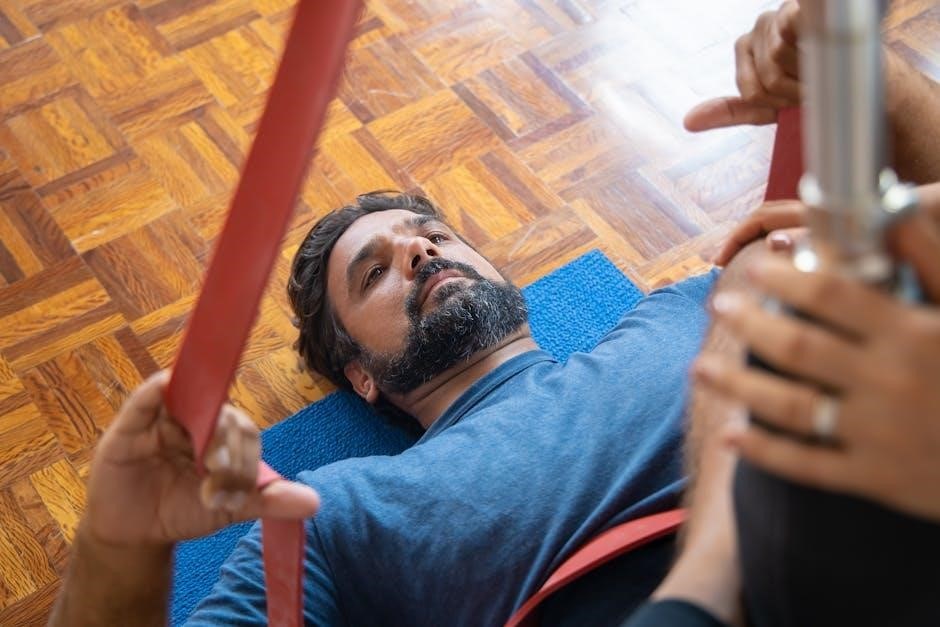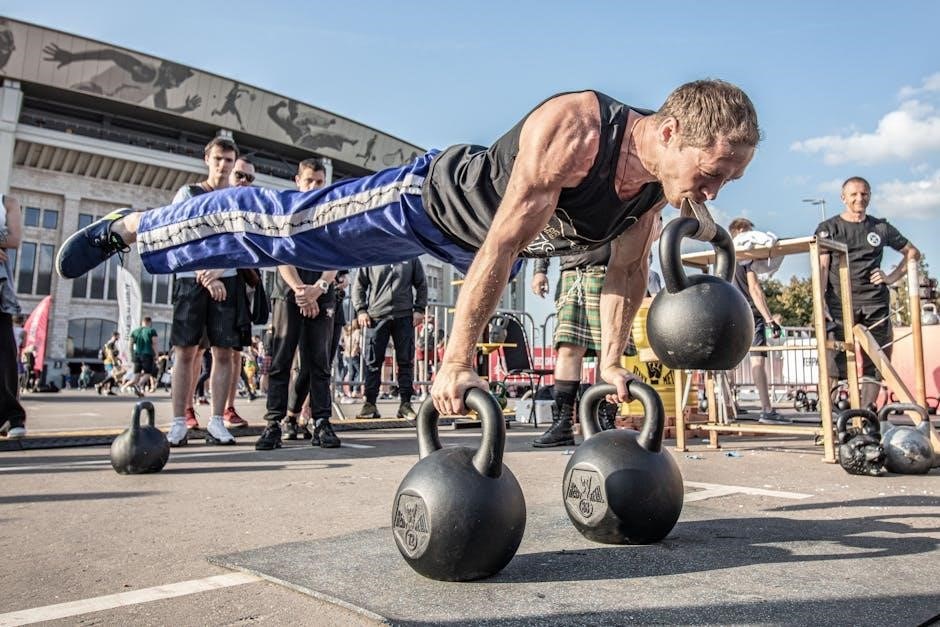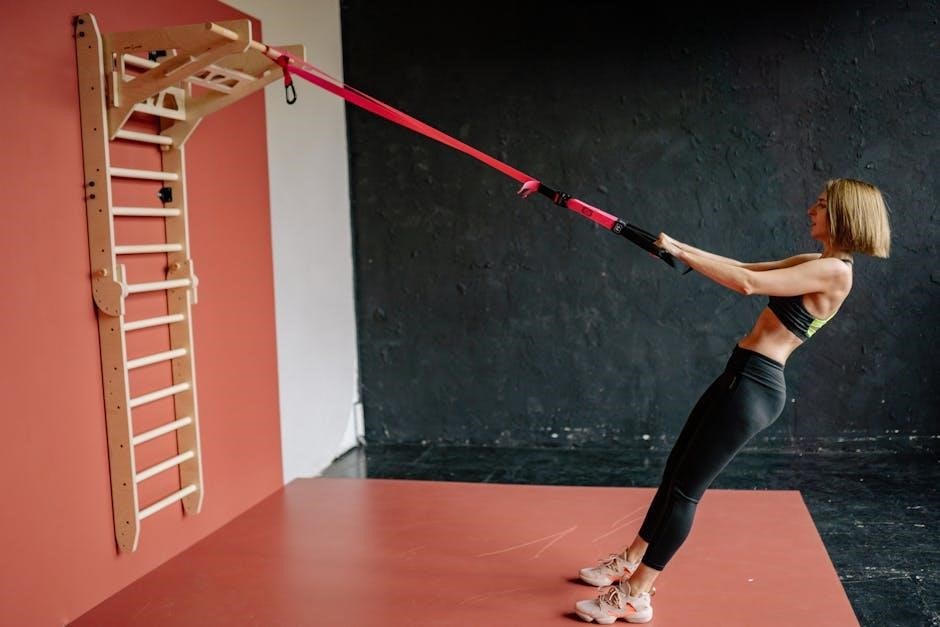Resistance bands are versatile, portable tools for strengthening core muscles. They offer lightweight, cost-effective workouts that target abs, obliques, and lower back. Perfect for all fitness levels, bands provide continuous resistance to build strength and endurance. Easily adaptable, they allow for dynamic movements that engage the entire core, making them ideal for full-body exercises anywhere, anytime.
1.1 What Are Resistance Bands?
Resistance bands are lightweight, flexible straps or tubes designed to provide resistance during exercises. They are typically made of durable rubber or latex, offering varying levels of tension to suit different fitness goals. Available in looped or handled designs, these bands are portable and versatile, allowing users to target specific muscle groups, including the core, arms, and legs. Unlike traditional weights, resistance bands rely on tension to create resistance, making them ideal for strength training, rehabilitation, and improving flexibility. They are a cost-effective and space-saving alternative to gym equipment.
1.2 Benefits of Using Resistance Bands for Core Training
Resistance bands offer numerous benefits for core training, including enhanced strength, improved flexibility, and increased stability. They provide continuous tension, engaging muscles throughout exercises, which helps build endurance and definition. Bands are lightweight and portable, making them ideal for workouts at home or on the go; They also allow for dynamic movements that mimic real-life actions, improving functional strength. Additionally, resistance bands are low-cost and space-efficient, making them accessible to everyone. They are versatile, enabling users to target specific muscle groups while promoting balanced development of the core muscles.
1.3 Why Core Strength Matters
Core strength is essential for stability, balance, and overall physical performance. A strong core supports proper posture, reduces the risk of injuries, and enhances athletic performance. It acts as the foundation for all movements, transferring power between the upper and lower body. Weak core muscles can lead to poor form, strain, and inefficiency in exercises. Resistance bands effectively target these muscles, improving functional strength and endurance. Building a strong core also boosts everyday activities, from lifting groceries to maintaining good posture, making it a vital component of total fitness and well-being.

Safety Tips for Using Resistance Bands
Inspect bands for damage before use, ensure proper form to avoid injury, and warm up thoroughly to prevent muscle strain during core exercises.
2.1 Proper Handling and Storage
Inspect resistance bands for cracks or tears before use. Clean with a soft cloth and mild soap to maintain hygiene. Store in a cool, dry place, avoiding direct sunlight and extreme temperatures. Roll bands neatly to prevent creases, which can weaken the material. Avoid leaving bands stretched for extended periods, as this may cause permanent damage. Proper storage ensures longevity and safety, preventing accidental breaks during exercises. Always handle bands gently to avoid overstretching, and keep them away from sharp objects to maintain their integrity.
2.2 Choosing the Right Resistance Level
Resistance bands come in varying levels, typically marked by color, from light to extra-heavy. Choose a band that aligns with your fitness level and goals. Lighter bands are ideal for beginners or rehabilitation, while heavier bands suit advanced users. Start with a lower resistance to focus on form and gradually increase as you build strength. Test the band’s tension by stretching it slightly; it should feel challenging but manageable. Proper resistance ensures effective workouts and prevents injury, allowing you to target core muscles safely and efficiently.
2.3 Warming Up Before Exercises

A proper warm-up is essential before starting resistance band core exercises. Begin with 5-10 minutes of light cardio, such as jumping jacks or jogging in place, to increase blood flow and prepare your muscles. Incorporate dynamic stretches like arm circles, leg swings, and torso twists to target the core and surrounding areas. Finish with gentle resistance band movements, such as banded planks or seated rows, to activate your muscles without overexertion. A thorough warm-up reduces injury risk and enhances workout performance.

Best Resistance Band Exercises for the Core
Resistance bands offer effective core exercises such as banded crunches, planks, and rotational movements. These target upper abs, lower abs, and obliques, promoting dynamic engagement and full-core stabilization.
3.1 Upper Abs Exercises
Target your upper abs with effective resistance band exercises like banded crunches and overhead presses. These movements engage the rectus abdominis, enhancing definition and strength. For banded crunches, anchor the band overhead, grip it tightly, and perform controlled crunches, keeping the lower back pressed into the floor. Overhead presses involve pressing the band away while maintaining core stability. Both exercises improve posture and reduce injury risk by strengthening the upper abdominal muscles. Focus on slow, deliberate movements to maximize engagement and avoid strain.
3.2 Lower Abs Exercises
Engage your lower abs with exercises like banded leg raises and reverse crunches. These movements target the lower rectus abdominis and hip flexors. For banded leg raises, anchor the band at ankle height, loop it around your feet, and lift your legs while maintaining a neutral spine. Reverse crunches involve lifting your hips with the band looped around your feet, enhancing lower abdominal engagement. These exercises improve core stability, posture, and overall lower body strength. Ensure controlled movements to maximize effectiveness and prevent strain.
3.3 Oblique Exercises
Target your obliques with resistance band exercises like banded Russian twists and side bends. For Russian twists, sit with knees bent, hold the band, and twist your torso side-to-side. Side bends involve anchoring the band, bending sideways, and pulling against the resistance. These exercises strengthen the internal and external obliques, improving rotational power and core stability. Maintain a tall posture and controlled breathing to maximize engagement and prevent injury. Incorporate these movements to enhance your functional strength and athletic performance effectively;
3.4 Full Core Engagements

Engage your entire core with exercises like banded plank rows and rotational pulls. Plank rows target abs, obliques, and lower back while improving stability. Rotational exercises, such as banded woodchoppers, enhance rotational strength and coordination. These movements require synchronization of upper and lower body, maximizing core activation. They improve functional strength, stability, and overall athletic performance. Incorporate these exercises to build a strong, balanced core that supports daily activities and sports. Resistance bands allow for dynamic, full-range movements that challenge the core from multiple angles effectively.

Sample Workout Routine Using Resistance Bands
A beginner-friendly routine includes 3 sets of 12-15 reps of banded crunches, lateral band walks, and seated pallof presses. Rest for 30-45 seconds between sets. For intermediates, add dynamic movements like banded Russian twists and leg raises. Advanced routines can incorporate compound exercises like banded plank rows and rotational presses. Adjust resistance levels and tempo to challenge your core progressively.
4.1 Beginner Routine
Start with foundational exercises like banded crunches (3 sets of 12-15 reps), targeting the upper abs. Follow with seated ab presses (3 sets of 10-12 reps) to engage the entire core; Include lateral band walks (3 sets of 10 steps per side) for oblique activation. Finish with seated banded rotations (3 sets of 15 reps per side) to improve rotational strength. Rest for 30-45 seconds between sets. Focus on slow, controlled movements to maximize engagement and avoid injury. This routine builds a strong core foundation and improves overall stability.
4.2 Intermediate Routine
For intermediates, incorporate dynamic movements and increased resistance. Begin with weighted banded crunches (3 sets of 15-20 reps) to intensify upper ab engagement. Transition to reverse banded crunches (3 sets of 12-15 reps) for lower abs. Add side plank with band rotations (3 sets of 10-12 reps per side) to target obliques. Include banded bird dogs (3 sets of 10-12 reps per side) for full core stabilization. Finish with banded Russian twists (3 sets of 15-20 reps per side) to enhance rotational strength. Rest for 30-45 seconds between sets, focusing on controlled, precise movements to avoid injury and maximize effectiveness.
4.3 Advanced Routine
For advanced users, incorporate complex movements and prolonged resistance. Start with single-arm banded crunches (4 sets of 15-20 reps) to challenge stability. Follow with banded superman holds (3 sets of 30-45 seconds) for lower back strength. Add banded woodchoppers (4 sets of 12-15 reps per side) to enhance rotational power. Conclude with a triset of banded side plank rotations, banded jackknives, and banded bicycle crunches (3 sets of 10-12 reps per exercise). Rest for 20-30 seconds between sets, focusing on controlled movements and full range of motion to maximize results and prevent injury.

Progressing Your Core Workouts
Progress your core workouts by increasing resistance, adding exercise variety, and incorporating dynamic movements. Adjust tempo and rest periods to challenge your core effectively.
5.1 Increasing Resistance
Incorporate progressively thicker resistance bands or layer multiple bands for added tension. This challenges the core muscles more intensely, promoting strength gains. To enhance resistance further, shorten the band by looping it around a stable object or adjusting your body positioning. For example, in banded crunches, reducing the band’s slack increases the workload on your abs. Gradually increasing resistance helps avoid plateaus, ensuring continuous progress in core strength and stability. This method is effective for advancing your workout routine safely and efficiently.
5.2 Adding Variety to Exercises
Exploring diverse resistance band exercises prevents plateaus and targets different muscle groups. Try banded crunches, Russian twists, and leg raises to engage upper and lower abs. Incorporate pallof presses for oblique strength and stability. Dynamic movements like banded rotations and side bends add variety while challenging the core. Mixing up exercises ensures comprehensive development and keeps workouts engaging. Varying tempos and angles further enhances muscle engagement, making sessions more effective and preventing monotony in your routine. This approach fosters overall core strength and functional fitness.
5.3 Incorporating Dynamic Movements
DYNAMIC movements with resistance bands enhance core engagement by introducing motion and flow. Exercises like banded rotations, figure-eights, and side-to-side shifts challenge stability and coordination. These movements simulate real-life actions, improving functional strength and flexibility. Incorporating tempo changes or pulses adds intensity, while maintaining control ensures proper form. Dynamic movements keep workouts engaging and prevent monotony, encouraging consistent progress. They also promote muscle endurance and balance, making them a valuable addition to any core training routine. This approach keeps the core active and adaptable, fostering overall physical fitness.

Modifying Exercises for Different Fitness Levels
Resistance bands allow easy adjustments to suit all fitness levels by altering resistance, range of motion, or tempo. This versatility ensures effective workouts for everyone, from beginners to advanced trainees.
6.1 Easier Variations
To make resistance band core exercises more accessible, use lighter bands or reduce the range of motion. For example, perform half crunches instead of full ones or modify plank holds by bending knees. Shortening the band’s length or using assistive devices can also lower resistance. Beginners can start with seated exercises like banded crunches or leg lifts, focusing on controlled movements. These adjustments help build foundational strength and confidence, making advanced exercises achievable over time.
6.2 More Challenging Variations
For advanced workouts, increase resistance by using thicker bands or layering multiple bands. Incorporate dynamic movements like explosive crunches or rotational twists. Elevate difficulty by anchoring the band higher or moving further from the anchor point, which increases tension. Try single-arm or single-leg exercises to engage stabilizers. Use unstable surfaces like a balance board for added challenge. Progress by increasing reps, sets, or resistance over time to build strength and endurance. These variations push the core to adapt to higher demands, enhancing overall performance.
6.3 Adjusting Tempo and Rest
Modify exercise tempo to increase intensity by slowing down movements or incorporating pauses. For example, hold a banded crunch for 2-3 seconds at the peak or extend the lowering phase. Shorten rest periods between sets to enhance endurance, or lengthen them for strength-focused routines. Experiment with tempo variations, like 2:1 or 3:1 ratios, to challenge muscles differently. Adjusting rest and tempo keeps workouts dynamic, prevents plateaus, and targets specific fitness goals, ensuring continuous progress in core strength and stability.
Common Mistakes to Avoid
Avoid using excessive force, which can cause injury. Ensure proper form to target the right muscles. Neglecting warm-ups and overstretching bands can lead to muscle strain or reduced effectiveness.
7.1 Overstretching the Bands
Overstretching resistance bands can reduce their effectiveness and lifespan. Bands are designed to stretch within specific limits; exceeding these can cause snaps or uneven resistance. Always check the manufacturer’s guidelines for maximum stretch capacity. Proper form ensures even tension without overextending. If a band begins to show signs of wear, such as fraying or thinning, replace it immediately. Maintaining controlled movements prevents excessive stretching, ensuring safe and effective workouts. Regularly inspect bands for damage to avoid accidents during exercises.
7.2 Improper Form
Improper form is a common mistake during resistance band exercises, leading to reduced effectiveness and increased injury risk. Slouching, rounding the back, or using momentum instead of muscle engagement can strain joints. Maintain a neutral spine, engage the core, and focus on slow, controlled movements. Avoid letting the band snap back forcefully, as this can cause muscle imbalances. Keep the chest upright and shoulders relaxed to ensure proper activation of target muscles. Consistent correct form maximizes workout benefits while minimizing potential harm. Always prioritize technique over resistance level or speed.
7.3 Insufficient Warm-Up
Insufficient warm-up is a critical mistake that can hinder the effectiveness of resistance band core exercises and increase injury risk. Failing to prepare the muscles and joints can lead to poor performance and discomfort. Always begin with light cardio, such as jogging in place or jumping jacks, followed by dynamic stretching to activate the core and improve flexibility. Neglecting this step can result in muscle strain or improper form during exercises. A proper warm-up ensures your body is ready for the workout, maximizing safety and results. Consistency in warming up is essential for long-term progress.

Nutrition and Recovery for Core Training
Nutrition and recovery are crucial for effective core training. Focus on a balanced diet rich in protein, hydration, and electrolytes to fuel workouts and aid muscle repair. Ensure adequate rest days and quality sleep to optimize recovery and muscle growth, supporting long-term core strength and overall fitness goals.
8.1 Importance of Protein Intake
Protein is essential for muscle repair and growth after core exercises. Resistance band workouts engage multiple muscle groups, and sufficient protein intake ensures proper recovery and strength gains. Aim for 1.2-2.2 grams of protein per kilogram of body weight daily, spread across meals. Include high-quality sources like lean meats, fish, eggs, dairy, and plant-based options. Protein-rich diets support muscle synthesis, helping you achieve a stronger, more defined core over time. Adequate hydration and electrolytes further enhance recovery, making protein intake a cornerstone of core training success. Consistency in nutrition accelerates progress and prevents muscle breakdown during intense sessions.
8.2 Hydration and Electrolytes
Hydration is crucial for optimal performance during resistance band core exercises. Water aids muscle contraction and prevents fatigue. Electrolytes, like sodium and potassium, maintain fluid balance and nerve function. Sweating during workouts depletes these minerals, potentially causing cramps or dizziness. Staying hydrated by drinking water before, during, and after sessions is essential. Replenish electrolytes with sports drinks or balanced meals. Proper hydration ensures muscle recovery and sustained energy, maximizing the effectiveness of core exercises while preventing dehydration-related issues. Adequate fluid intake supports overall physical performance and recovery, keeping you ready for challenging workouts. Electrolyte balance is key to maintaining peak fitness levels. Consistent hydration habits will enhance your training results and overall well-being.

8.3 Rest Days and Sleep
Rest days and quality sleep are essential for muscle recovery and growth. During sleep, your body repairs and strengthens core muscles worked by resistance bands. Aim for 7-9 hours of sleep nightly to support muscle repair and hormone regulation. Rest days allow your core muscles to recover, preventing overtraining and injury. Without adequate rest, performance may decline, and recovery slows. Prioritize sleep and rest to maximize the benefits of your resistance band core exercises. Consistent rest and sleep habits will enhance muscle recovery, ensuring you stay strong and motivated for future workouts. Proper recovery is key to long-term progress and overall well-being.
Resistance band core exercises offer a versatile, effective way to strengthen your core. With consistent use and proper form, you can achieve significant improvements in stability and strength, enhancing overall fitness and performance.
9.1 Summary of Key Points
Resistance band core exercises are a versatile and effective way to strengthen and stabilize the core muscles. They target the abs, obliques, and lower back, improving overall stability and posture. These exercises are adaptable to all fitness levels, from beginners to advanced users, and can be performed anywhere. Resistance bands are lightweight, portable, and cost-effective, making them a practical choice for home or travel workouts. Consistent use and proper form are essential to maximize results and prevent injury, ensuring a strong and functional core.
9.2 Encouragement to Continue Training
Congratulations on starting your resistance band core exercise journey! Consistency is key to achieving stronger, more defined core muscles. Remember, every workout brings you closer to improved posture, balance, and overall physical strength. Resistance bands are a convenient and effective tool that can be used anywhere, making it easy to stay committed. Celebrate small victories, track your progress, and embrace the challenges. With dedication, you’ll enjoy the benefits of a stronger core, enhanced athleticism, and better overall health. Keep pushing forward and watch your hard work pay off!
Additional Resources
Explore recommended PDF guides, online tutorials, and community forums for comprehensive guidance on resistance band core exercises, tips, and expert advice to enhance your workout routine effectively;
10.1 Recommended PDF Guides
Discover comprehensive PDF guides offering detailed workout plans, exercise tutorials, and nutritional advice for optimizing core training with resistance bands. These guides provide step-by-step instructions, progression tips, and safety guidelines to ensure effective and injury-free workouts. Suitable for all fitness levels, they include variations for beginners, intermediates, and advanced athletes. Many guides also cover topics like proper form, equipment care, and workout scheduling. Downloadable and printable, they are perfect for home workouts or on-the-go training, helping you maximize your core strength and overall fitness journey.
10.2 Online Tutorials and Videos
Enhance your resistance band core workouts with online tutorials and videos. These resources provide visual demonstrations of exercises, proper form, and progression techniques. Platforms like YouTube and fitness websites offer free and paid content, catering to all fitness levels. Many videos include expert tips, modifications, and full routines to target specific muscle groups. Whether you’re a beginner or advanced, these tutorials help you master resistance band exercises, ensuring safe and effective core strengthening. They also often include variations and dynamic movements to keep your workouts engaging and challenging.
10.3 Community Forums and Support Groups
Joining community forums and support groups can enhance your resistance band core workout journey. These platforms connect you with like-minded individuals, trainers, and enthusiasts. Share tips, ask questions, and gain motivation from others. Many forums offer personalized advice, progress tracking, and accountability. Groups like Reddit’s fitness communities or specialized Facebook groups provide a space to discuss exercises, routines, and challenges. Engaging with others can help you stay consistent, learn new techniques, and celebrate milestones, fostering a sense of belonging and support as you achieve your fitness goals.


